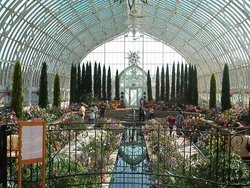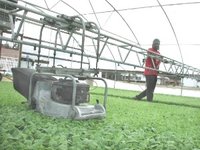Greenhouse
|
|

A greenhouse (also called a glasshouse or hothouse) is a building where plants are cultivated. A greenhouse is built of glass or plastic; it heats up because the sun's incoming electromagnetic radiation warms plants, soil, and other things inside the building. Air warmed by the heat from hot interior surfaces is retained in the building by the roof and wall.
The glass used for a greenhouse works as a selective transmission medium for different spectral frequencies, and its effect is to trap energy within the greenhouse, which heats both the plants and the ground inside it. This warms the air near the ground, and this air is prevented from rising and flowing away. This can be demonstrated by opening a small window near the roof of a greenhouse: the temperature drops considerably. Greenhouses thus work by trapping electromagnetic radiation and preventing convection. See Solar greenhouse (technical) for a more technical discussion of solar greenhouse workings.
Greenhouses are often used for growing flowers, vegetables, fruits, and tobacco plants. Bumblebees are the pollinators of choice for most greenhouse pollination, although other types of bees have been used, as well as artificial pollination.

Besides tobacco, many vegetables and flowers are grown in greenhouses in late winter and early spring, then transplanted outside as the weather warms. Started plants are usually available for gardeners in farmers markets at transplanting time.
The closed environment of a greenhouse has its own unique requirements, compared with outdoor production. Pests and diseases, and extremes of heat and humidity, have to be controlled, and irrigation is necessary to provide water. Significant inputs of heat and light may be required, particularly with winter production of warm-weather vegetables. Special greenhouse varieties of certain crops, like tomatoes, are generally used for commercial production.
Greenhouses are increasingly important in the food supply of high latitude countries. The largest greenhouse complex in the world is at Leamington, Ontario (close to Canada's most southern spot) where about 200 acres (0.8 km²) of tomatoes are entirely grown under glass.
Greenhouses protect crops from too much heat or cold, shields plants from dust storms and blizzards, and helps to keep out pests. Light and temperature control allows greenhouses to turn unarable land into arable land. Greenhouses can feed starving nations where crops can't survive in the harsh deserts and arctic wastes. Hydroponics can be used in greenhouses as well to make the most use of the interior space.
See also
External links
- North Carolina State University Greenhouse Food Production website (http://www.ces.ncsu.edu/depts/hort/greenhouse_veg)
- Organic Greenhouse Tomato Production (http://attra.ncat.org/attra-pub/ghtomato.html)
- Greenhouse Supplies (http://greenhousestuff.com)
- Greenhouse Articles and Resources (http://primegreenhouse.com/newsarticles)de:Gewächshaus
es:Invernadero id:Rumah hijau it:Serra he:חממה nl:Kas ja:ビニールハウス
